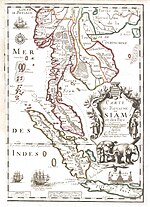Wen Dan
Wen Dan (Văn đơn) | |
|---|---|
| 7th century–8th century | |
| Capital | Kantharawichai[1] |
| Religion | Buddhism |
| Historical era | 7th-8th century |
• Established | 7th century |
• Disestablished | 8th century |
| History ofThailand |
|---|
 |
|
|
Wén Dān(Chinese:Văn đơn;Thai:เหวินตัน) was a group of ancientMonpolitical entitiesthat existed around the 7th–8th centuries CE in the interior ofmainland Southeast Asiascattered around the centralMekong Valleyin the present-daynortheast Thailand.[1][2][3]It was mentioned in the Chinese annals of theTang period(618-907 AD) as a dependency on the trans-Mekong trade route from the ancient city of Chiaochih (jiāo zhǐ giao ngón chân; Giao chỉ; near the present-dayVinhof Vietnam) to India.[1]: 25–72 Wen Dan sent representatives to China in 656 – 661, 717, 753, 771, and 798.[1][4]
Initially, Wen Dan was believed to be eitherVientiane,[1][2]or the capital of theLand Chenla(Po-Lou),[5]: 16 but according to the location given in the annals as well as archaeological evidence, it is supposed to be inChi Riverbasin,[1][2]centered inKantharawichai,withMueang Fa Daet Song Yangas outer center and Champasri (จัมปาศรี;in presentNa Dun district) as the vassal.[1]Several historical evidences supports the connection between Wen Dan andSi Thepin central Thailand.[4]: 91–92
According to theDvaravatiBuddhist boundary stones (Bai sema) dated the 8th century found onMt. Kulen,Woodward(2003) proposes that Wen Dan once controlled the Angkor region beforeJayavarman IIproclaimed the independence of the Kambujadesa fromJavain 802.[4]: 87–88 Jayavarman IIprobably either defeated Wen Dan and then moved the capital fromIndrapuratoYaśodharapurain the north,[4]: 87 or formed ally with the communities inMunandChiwatersheds to againstSi Thepin the west.[4]: 93
Records
[edit]After theTang dynastywas defeated byNanzhaoin the trade routes conflicts in 753 and 755, the King of Wen Dan sent his son and 26 generals to China to help the fight.[1][3]
In 766, a Tang army of 70,000, led by General Li Mi fromSichuan,invadedNanzhao.Vietnamese Governor "He Lu Guang" joined Wen Tan in attacking the south, but Ko-lo-Feng, the Nanzhao king, captured General Li and won. Wendan's army returned home. In 771, the prince of Wen Dan went to China and was titled "Special Highest Local Commander," equal to the King ofNanzhao,and was even higher than the Chinese governors in Vietnam andGuangzhou.[1][3]
Architecture
[edit]This section is empty.You can help byadding to it.(April 2024) |
References
[edit]- ^abcdefghiTatsuo Hoshino (2002). "Wen Dan and its neighbours: the central Mekong Valley in the seventh and eighth centuries". In Mayoury Ngaosrivathana; Kennon Breazeale (eds.).Breaking new ground in Lao history: essays on the seventh to twentieth centuries.Chiang Mai: Silkworm Books. Archived fromthe originalon 9 April 2024.
- ^abcJohn N. Miksic; Goh Geok Yian (2017).Ancient Southeast Asia.Routledge. p. 654.ISBN9780415735544.
- ^abcCharles Backus (1983). "The Nan-chao Kingdom and T'ang China's Southwestern Frontier".The Journal of Asian Studies.43(1): 130–132.doi:10.2307/2054621.JSTOR2054621.
- ^abcdeHiram Woodward (2023)."Dvaravati, Si Thep, and Wendan".Archived fromthe originalon 15 October 2022.
- ^Ferlus, Michel(2012)."Linguistic evidence of the trans-peninsular trade route from North Vietnam to the Gulf of Thailand (3rd-8th centuries). Mon-Khmer Studies, Michel FERLUS"(PDF).Archived fromthe original(PDF)on 10 January 2020.Retrieved20 March2021.
- Former countries in Thai history
- Former countries in Southeast Asia
- Former monarchies of Asia
- Indianized kingdoms
- States and territories established in the 7th century
- 7th-century establishments in Thailand
- 8th-century disestablishments in Thailand
- 1st millennium in Thailand
- Former monarchies of Southeast Asia
